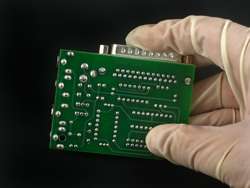Multi-functional decorative coatings for electronics

European researchers developed a new class of thin-film coatings with a huge spectrum of mechanical, optical and electrical properties. Tailor-made combinations of properties should make the coatings a winner with the consumer electronics sector.
Thin-film coatings are widely used throughout the medical, automotive and machine tools industries. They provide additional resistance to a number of conditions detrimental to the life and function of components.
Thin-film coatings are also important to the electronics and optics industries. They play a major role in the semiconductor sector and in electrical connections on circuit boards. Optical coatings are applied to everything from household mirrors to photovoltaic (PV) cells.
More recently, decorative thin film coatings in a wide range of colours have made consumer electronics a bit more fun than black, white and silver.
European researchers set out to develop new coatings for decorative and micro-optoelectronics applications via the ‘Development of new hard decorative coatings based on transition metal oxynitrides’ (Hardecoat) project.
Scientists developed a new range of coatings, transition metal oxynitrides (TM-O-N), combining the strength of nitrides with the colours attainable using oxides. In addition, transition metals have interesting electrochromic properties, or the ability to change their optical properties in response to a small voltage in applications such as ‘smart’ windows or X-ray mirrors. As metals, they also can act as conductors or semiconductors.
Integrating all these potential characteristics in one class of compounds and exploring the vast spectrum of possible combinations was the goal of the Hardecoat project.
In addition, investigators opted to modify the physical vapour deposition (PVD) method, specifically reactive sputtering, for deposition of the novel coatings. PVD produces much less negative environmental impact than conventional electroplating or chemical vapour deposition methods that use toxic chemicals and produce a large amount of waste.
Four modified reactive sputtering processes were developed for TM-O-N thin-film deposition. Coatings demonstrated a range of colours, optical and electrical properties as well as excellent resistance to corrosion and wear.
Hardecoat coatings, with their rich spectrum of tuneable properties, should make a significant impact on the decorative, opto-electronic and micro-technology sectors. In addition, the cost-effective and environmentally friendly deposition processes should be welcomed by manufacturers and consumers alike.
Provided by CORDIS


















